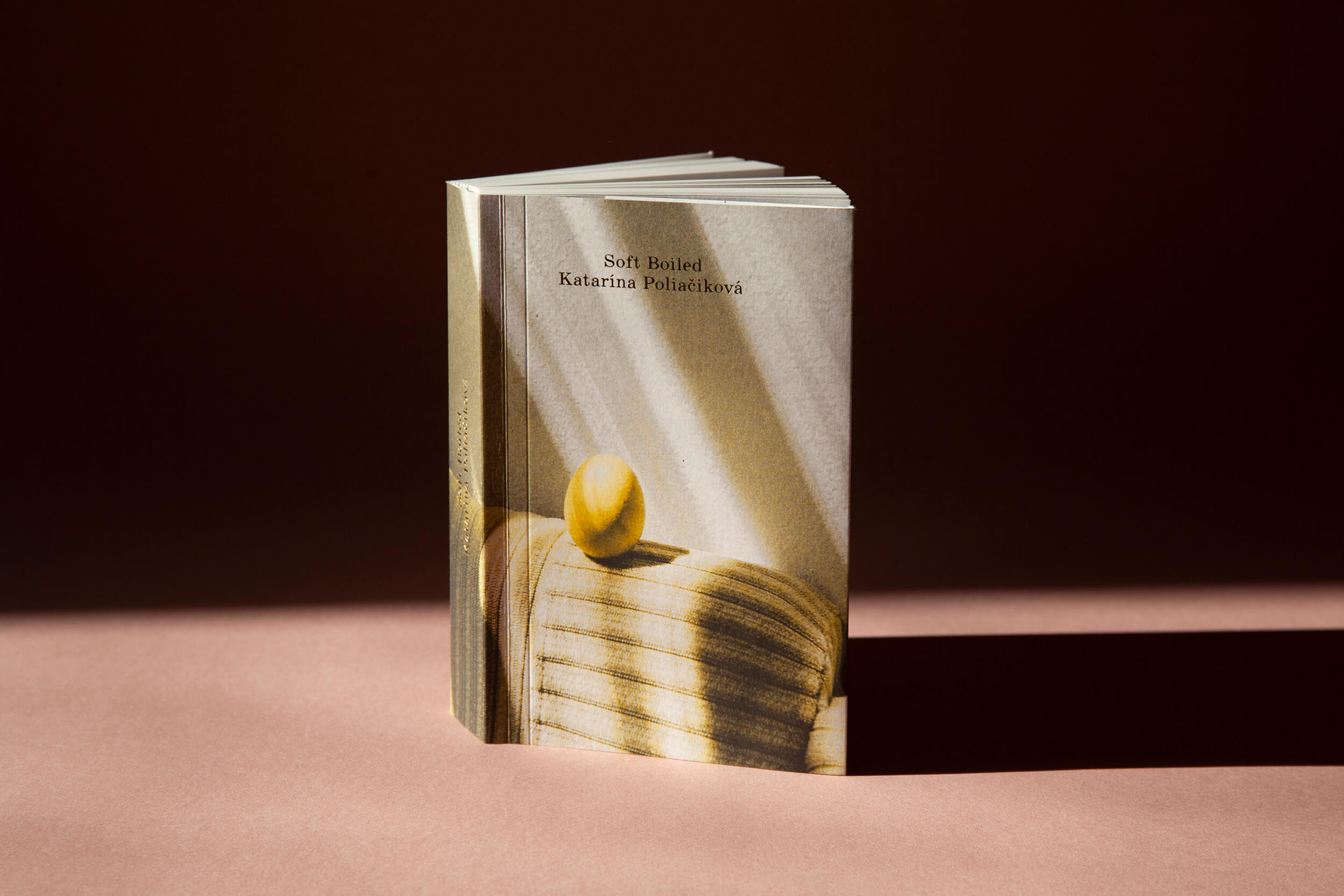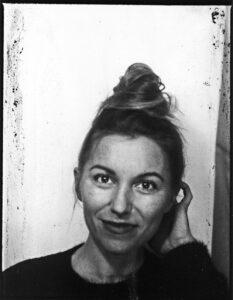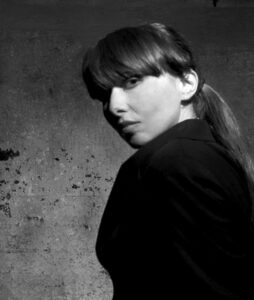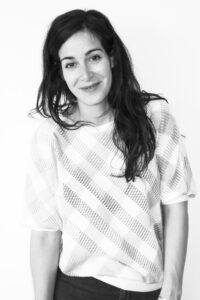Katarína Poliačiková
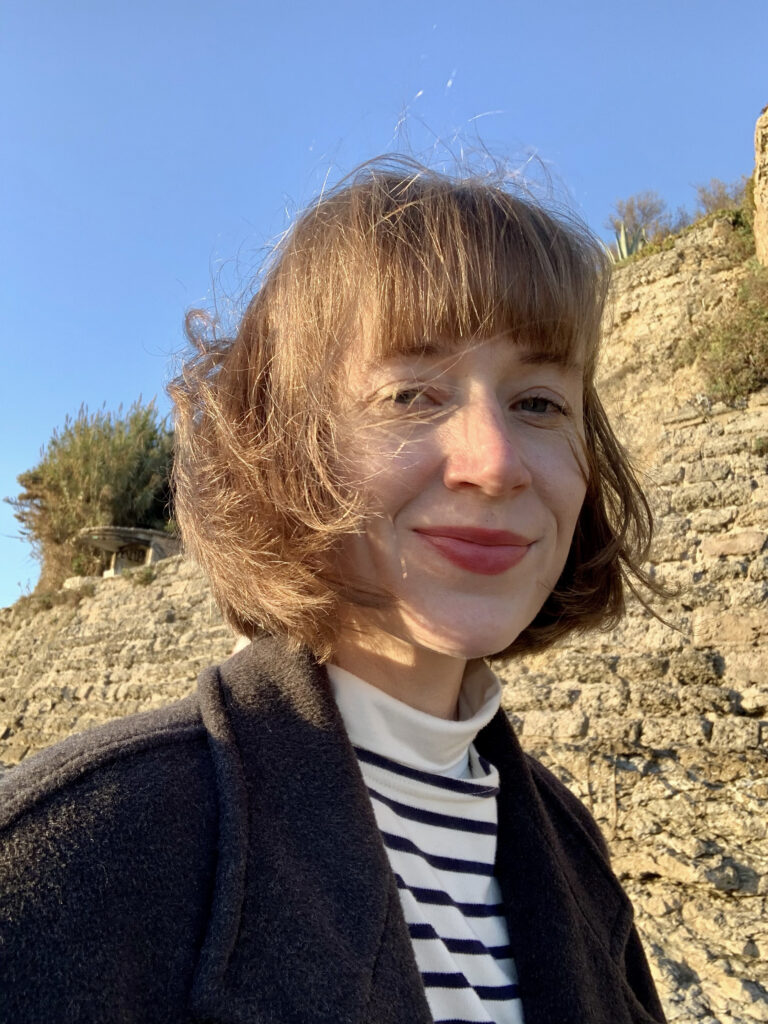
– born in 1982 – is a graduate of the Academy of Fine Arts in Bratislava. She has exhibited in Bratislava, Prague, Berlin, New York, Lisbon and other cities. She has participated in numerous residencies in Europe and New York. In 2011, she was a finalist of the Oskar Čepán Award. The artist is represented by Jiri Svestka Gallery, which published her two original books Skipping School, Learning the Fire of Things (2019) and Soft Boiled (2021). She lives in Bratislava.
For me, art work is a way of relating to the world, of reflecting on it. At the beginning there is always something that sparks my interest – a moment, a story, a found photo – I get excited and I go from there. When I was preparing an exhibition for the The National Museum of Natural History and Science in Lisbon, I decided to work with a site-specific context and I discovered a key moment in the history of the institution – a large fire of 1978. This was followed by a period of few months when I thought about how to talk about this through art. At last, I decided to exhibit objects that have literally lived through a fire – burnt fossils. For forty years, they were stored in the archive, having lost their scientific value. At the same time, the institution did not want to throw them away, because they carried a different – we could say emotional – value. I had brought them back into the exhibition space of a museum. It was a very simple, but in a way radical gesture, which raised questions instead of becoming an answer itself.
My artistic research is built more on the foundation of a childlike curiosity; in contrast to many artists who focus on research, I rarely work in a planned and structured way. Rather, the way I think about it is that things open up before me and I react to them and create a new context for them. When I create, the most important for me is the balancing between the intuitive and the rational/guided. I think quite conceptually, yet at the same time I leave space for the “unnamed”, possibly magical, something that is not entirely in my control. Perhaps we could say: „Let the world speak for itself.” There are themes that have been appearing in my work constantly for a long time. If I were to mention only one, perhaps the most important one, it would be the connecting of the personal/intimate to the large, universal, that what transcends us. And also how it is possible to speak about something much larger precisely through personal stories.
For me, art work is being, it’s a kind of positioning, a way of being present in the world. Attention to objects, stories, relationships. This is something I remember from my childhood and not much has actually changed for me there. In creative work, it is then a question of cultivating this childlike curiosity and deepening the skill to push it further. The work starts when I tell myself this is something I want to share with others through an artwork. Then I think about how to transfer this experience and talk about it so that it transcends the plane of personal fascination. Why should it matter to someone else? There are many things and moments that catch my attention every single day, and not everything I wish or am able to carry into art.
It is interesting and important for me that I am present and work in diverse contexts, that I perceive the differences and thus have a more complex idea of the art world. Sometimes there is much more of what connects us than we think. There was a time when I travelled a lot and lived in different cities. These past years I have had a preference for returning to Lisbon or New York, where I already have a social network, relationships and projects I work on. These two cities are different, but I realised recently that in each of them I can experience a different part of myself, hence our close relationship.
For a long time I avoided calling myself a photographer. Only after about a decade of working in a rather conceptually informed way did I start to approach photography more freely. Visuality and light have always been important to me, and I am no longer ashamed to display “pretty” photos. It it strange to mature into this freedom. I guess it’s only natural that I am drawn towards this medium, as time has always been a big subject for me and my practice has always been about observing and the subsequent “editing” of the seen, which is essentially the principle of photography. Shots from the NASA archive, anonymous photos found at a market, my own iPhone or analogue photos – they are all equal to me. The difference only lies in deciding which ones I will use. Photography is simply like text for me, like writing – I choose what slice of the world to depict.
At first, however, I would consider my texts and my visual works separate. Gradually, I found a way to connect them. In original books and video essays, I find spaces where I am able to explore these connections. The link they offer differs from project to project. I am not able to express everything only through text or only visually, I therefore feel comfortable“straddling” between the two. Eggtuition, the newsletter containing my original texts was born, among other things, from a desire to reach a different audience and to create a new context and options for myself. Writing provides me that, which is very important for me. I started writing in English and so far this remains so; a foreign language offers me distance while simultaneously forcing me to formulate my thoughts very precisely.
I feel very close to the feminism that, for example, Agnès Varda developed in her work and in her life. Her work is about attention towards various stories, about giving space to the people and events that would not be heard otherwise. The question of gender is therefore not something I put an explicit focus on in my work. At some point I realised that I am the first in the line of women in my family to be able to pursue what she chose in her life. And that this is part of a historical, social, feminist context that goes beyond our family. I was raised by a single mother and I am more and more aware of how this environment shaped me. Ever since I was a child, I was used to the the idea of a woman being independent and making her own decisions, it seemed like the most natural thing for me. But I also recognised another aspect of our, or rather my mother’s, situation: that single mothers have it very hard, not only financially but socially, because they are seen as inferior next to “complete” families. My mom and I kind of muddled through, but in hindsight I am grateful for the experience. I remember one summer we made extra money by cleaning the school I attended and she taught at during the school year. My mother is an intellectual but she possesses a deep social awareness and taught me to appreciate the value of work, any work, and not to discriminate between people based on status. This way she gave me some foundation on which I still draw. When I was working on the book DAY for Bratislava City Gallery, and a short essay was born about the act of getting to know a space through the people who take care of it, for example the cleaners, I was not writing about myself, but from a place of my own experience nonetheless, and this authenticity was important to me.
The text was written in collaboration with Miroslava Urbanová (2022).
1Image: DEŇ, 2021, author's publication for the 60th anniversary of the Bratislava City Gallery, photo: Adam Šakový.2Image: DEŇ, 2021, author's publication for the 60th anniversary of the Bratislava City Gallery, photo: Adam Šakový.
3Image: The way geologists liberated in time, she thought, astronomers are freed by space, 2013-photographic installation, photo: Radek Brousil.
4Image: The way geologists liberated in time, she thought, astronomers are freed by space, 2013-photographic installation, photo: Radek Brousil.
5Image: Fire at the Museum of Natural History in Lisbon, 1978, photo: archive of the institution.
6Image: Souvenirs of Fire, 2019, site-specific installation in the Museum of Natural History in Lisbon, photo: JPS Undercover.
7Image: Souvenirs of Fire, 2019, site-specific installation in the Museum of Natural History in Lisbon, photo: JPS Undercover.
8Image: Soft Boiled, 2021 a book of author's essays and photographs, photo: Peter Sit.
9Image: Soft Boiled, 2021 a book of author's essays and photographs, photo: Peter Sit.
– sa narodila v roku 1982 – je absolventkou Vysokej školy výtvarných umení v Bratislave. Vystavovala v Bratislave, Prahe, Berlíne, New Yorku, Lisabone a ďalších mestách. Zúčastnila sa mnohých rezidenčných pobytov v Európe a v New Yorku. V roku 2011 bola finalistkou Ceny Oskára Čepana. Umelkyňu zastupuje Jiri Svestka Gallery, ktorá vydala jej dve autorské knihy Skipping School, Learning the Fire of Things (2019) a Soft Boiled (2021). Žije v Bratislave.
Umelecká tvorba je pre mňa spôsob vzťahovania sa k svetu, uvažovania o ňom. Na začiatku je vždy niečo, čo ma zaujme – moment, príbeh, nájdená fotka – nadchnem sa a potom to rozvíjam. Keď som pripravovala výstavu pre Prírodovedné múzeum v Lisabone, rozhodla som sa pracovať s kontextom miesta a objavila som jeden kľúčový moment v histórii inštitúcie, ktorým bol veľký požiar v roku 1978. Nasledovalo niekoľko mesiacov, keď som uvažovala, ako o tom rozprávať cez umenie. Nakoniec som sa rozhodla vystaviť objekty, ktoré si doslova prešli ohňom – zhorené fosílie. Celých štyridsať rokov boli uložené v archíve, pretože stratili vedeckú hodnotu. Zároveň ich nechceli vyhodiť, pretože niesli inú – dá sa povedať, že emocionálnu – hodnotu. Ja som ich vrátila do priestoru muzeálnej expozície. Bolo to veľmi jednoduché, ale v niečom radikálne gesto, ktoré skôr otváralo otázky a akoby sa samo stalo odpoveďou.
Umelecký výskum je u mňa postavený skôr na báze detskej zvedavosti, málokedy postupujem, na rozdiel od mnohých umelcov*kýň, ktorých tvorba je orientovaná na výskum, cielene a štruktúrovane. Skôr to vnímam tak, že veci sa otvárajú predo mnou a ja na ne reagujem a vytváram pre ne nový kontext. Keď tvorím, je pre mňa najdôležitejšie jemné balansovanie medzi intuitívnym a racionálnym/riadeným. Premýšľam dosť konceptuálne, ale zároveň nechávam priestor pre niečo „nepomenované“, možno magické, niečo, nad čím nemám úplnú kontrolu. Možno by sa dalo povedať „nechať svet hovoriť cez seba“. Mám témy, ktoré sa objavujú v mojej tvorbe kontinuálne už dlho. Ak by som mala pomenovať len jednu z nich, možno tú najdôležitejšiu, je to vzťahovanie sa osobného/intímneho k veľkému, univerzálnemu, nás presahujúcemu. A to, ako je možné práve cez osobné príbehy hovoriť o niečom oveľa väčšom.
Tvorba je pre mňa bytie, spôsob nastavenia, prítomnosti vo svete. Pozornosť k veciam, príbehom, vzťahom. To je niečo, čo si pamätám z môjho detstva a vlastne sa v tom pre mňa veľa nezmenilo. V tvorbe potom ide o kultivovanie tejto detskej zvedavosti a prehlbovanie schopnosti posunúť ju ďalej. Práca nastupuje, keď si poviem, že toto je niečo, čo chcem zdieľať s inými práve cez dielo. Vtedy sa zamyslím, ako túto skúsenosť preniesť a rozprávať o nej tak, aby presiahla úroveň osobnej fascinácie. Prečo by to malo zaujímať niekoho iného? Počas každého jedného dňa ma upúta veľmi veľa vecí a momentov, a nie všetko chcem alebo dokážem posunúť do roviny umenia.
Je pre mňa zaujímavé a tiež dôležité byť prítomná a pracovať v rôznych kontextoch, vnímať rozdiely a mať tak komplexnejší obraz o umeleckom svete. Niekedy je toho, čo nás spája viac, ako si myslíme. Mala som obdobie, kedy som veľa cestovala a žila v rôznych mestách. V posledných rokoch uprednostňujem návraty do Lisabonu a New Yorku, kde mám už sociálne zázemie, vzťahy a projekty, ktoré tam rozvíjam. Sú to veľmi odlišné mestá, ale nedávno som si uvedomila, že v každom z nich môžem zažívať inú časť mojej osobnosti, aj preto tá blízkosť.
Dlho som sa vyhýbala tomu, aby som sa nazývala fotografkou. Až po asi desiatich rokoch práce konceptuálne vyhraneným spôsobom som začala pristupovať k fotke voľnejšie. Vizualita a svetlo boli pre mňa vždy dôležité a už sa nehanbím vystaviť „pekné“ fotky. Je to zvláštne, dozrieť k tejto voľnosti. Asi je prirodzené, že inklinujem práve k tomuto médiu, keďže čas bol vždy mojou veľkou témou a môj spôsob tvorby bol vždy o pozorovaní a následnom „editovaní“ videného, čo je v podstate princíp fotografie. Zábery z archívu NASA, anonymné fotografie nájdené v bazári, moje vlastné fotky z iPhonu alebo analógu – všetky sú pre mňa rovnocenné. Rozdiel je len v tom, kedy sa ktoré rozhodnem použiť. Fotografia je pre mňa vlastne ako text, ako písanie – vyberám, aký výsek sveta zobraziť.
Moje texty a moje vizuálne diela som však vnímala najprv oddelene. Postupne som našla spôsob, ako ich spájať. Autorské knihy a video eseje sú miesta, kde môžem tieto prepojenia skúmať. Spojenie, ktoré ponúkajú, sa líši od projektu k projektu. Nie všetko je pre mňa možné vyjadriť výlučne v texte alebo výlučne vizuálne, a preto mi vyhovuje byť „rozkročená“ medzi nimi. Newsletter s autorskými textami Eggtuition vznikol aj z túžby trochu sa oslobodiť od uzavretého sveta vizuálneho umenia a kontextu výstav, pretože ma to po čase začalo unavovať a demotivovať. Mala som túžbu prehovoriť k inému publiku a vytvoriť si nový kontext a možnosti sama pre seba. Písanie mi to poskytuje a je to pre mňa veľmi dôležité. Začala som písať v angličtine, a tak to zatiaľ ostalo. Cudzí jazyk mi poskytuje istý odstup, pričom ma zároveň núti veľmi presne formulovať myšlienky.
Je mi veľmi blízky feminizmus, ktorý vo svojej tvorbe a v živote rozvíjala napríklad Agnès Varda. U nej sa jedná o pozornosť voči rôznym príbehom, poskytovaní priestoru ľuďom alebo udalostiam, o ktorých by inak nebolo počuť. Otázka rodu teda nie je niečo, čomu sa v mojej tvorbe venujem explicitne. V nejakom momente som si uvedomila, že som úplne prvá zo ženskej línie našej rodiny, ktorá sa môže v živote venovať tomu, čo chce. A že to má nejaký historický, spoločenský, feministický kontext, ktorý presahuje našu rodinu. Vyrastala som so slobodnou matkou a čoraz viac si uvedomujem, ako výrazne ma toto prostredie formovalo. Bola som od detstva zvyknutá na to, že žena je samostatná a robí vlastné rozhodnutia, javilo sa mi to ako tá najnormálnejšia vec na svete. Ale vnímala som aj iný aspekt našej, alebo skôr maminej situácie – že slobodné matky to majú veľmi ťažké, nielen finančne ale i spoločensky, lebo sa na ne nazerá ako na menejcenné v porovnaní s „kompletnými“ rodinami. S mamou sme sa tak trochu pretĺkali, ale spätne som za tieto skúsenosti vďačná. Pamätám si, ako sme si cez jedno leto privyrábali tak, že sme upratovali školu, kde ona počas školského roka učila a ja som bola žiačkou. Mama je intelektuálne založená, ale má veľké sociálne cítenie a naučila ma vážiť si hodnotu práce, a to akejkoľvek, nerobiť rozdiely medzi ľuďmi na základe statusu. Takto mi dala základ, z ktorého stále vychádzam. Keď som pracovala na knihe DEŇ pre Galériu mesta Bratislavy, vznikala krátka esej o poznaní priestoru tými, ktorí sa oň starajú, napríklad upratovačkami. Nepísala som síce o sebe, ale predsa z miesta vlastnej skúsenosti a táto autentickosť bola pre mňa dôležitá.
Text bol napísaný v spolupráci s Miroslavou Urbanovou (2022).
1Obrázok: DEŇ, 2021, autorská publikácia k 60. výročiu Galérie mesta Bratislava, foto: Adam Šakový.2Obrázok: DEŇ, 2021, autorská publikácia k 60. výročiu Galérie mesta Bratislava, foto: Adam Šakový.
3Obrázok: The way geologists liberated in time, she thought, astronomers are freed by space, 2013-fotografická inštalácia, foto: Radek Brousil.
4Image: The way geologists liberated in time, she thought, astronomers are freed by space, 2013-fotografická inštalácia, foto: Radek Brousil.
5Obrázok: Požiar v Prírodovendom múzeu v Lisabone, 1978, foto: archív inštitúcie.
6Obrázok: Souvenirs of Fire, 2019, site-specific inštalácia v Prírodovendom múzeu v Lisabone, foto: JPS Undercover.
7Obrázok: Souvenirs of Fire, 2019, site-specific inštalácia v Prírodovendom múzeu v Lisabone, foto: JPS Undercover.
8Obrázok: Soft Boiled, 2021 kniha autorských esejí a fotografií, foto: Peter Sit.
9Obrázok: Soft Boiled, 2021 kniha autorských esejí a fotografií, foto: Peter Sit.
